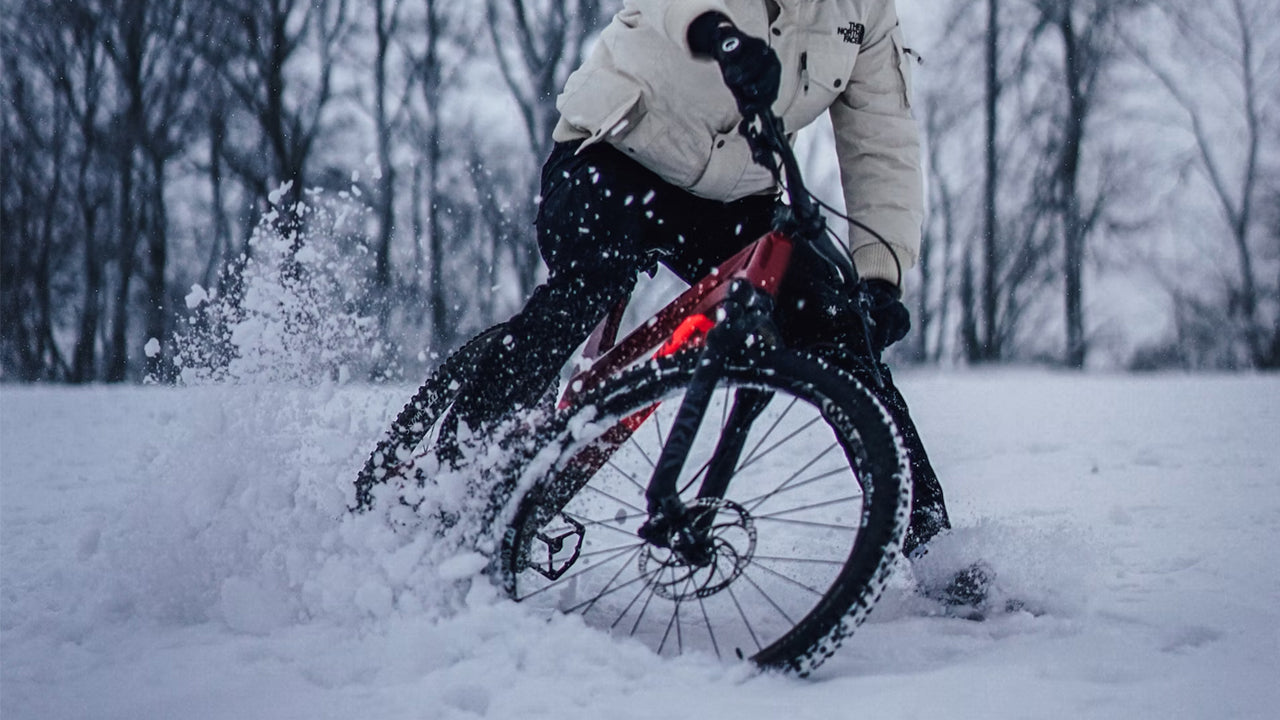With miles of scenic shoreline and soft sand, beaches can provide a fun environment for e-bike riding if you take the right precautions. This guide covers tips for choosing an e-bike designed for stability on the sand, making pre-ride preparations, mastering sand riding skills, and properly caring for your bike after exposure to saltwater and sand. You'll also find safety recommendations and a list of top-rated beaches for e-biking in the U.S. Follow this advice for maximum enjoyment of your seaside e-bike adventures.
Choosing an E-bike Suited for the Sand
When it comes to riding on sand, not all e-bikes perform equally. To truly optimize your beach e-biking adventures, carefully select a model designed to excel in those sandy conditions. Keep an eye out for these ideal features:
1. Fat Tire E-bikes
Fat tire e-bikes reign supreme for tackling soft sand. Seek out extra wide tires - 3 to 4 inches. The increased width boosts the contact patch, providing enhanced traction and stability as you roll across loose beach sand. With more surface area gripping the ground, these wider tires resist sinking in and slipping as effectively as possible. Fat tires also allow you to deflate to lower PSI for further traction while maintaining cushion and floatation on the yielding surface.
2. Motor Power and Speed
Look for an e-bike with adequate motor power, typically 500 to 1000 watts, to help propel you through soft sand patches. Top speeds of 18-25 mph should suffice for beach riding fun without being too fast. Higher speeds can be more difficult to control in sand.
3. Water Protection
Since the ocean environment can expose your e-bike to salt, moisture, and sand, opt for a water-resistant, beach-ready model. Look for aluminum or stainless steel frames and components that can withstand those elements better than steel. Water protection ratings (IP ratings) indicate the level of water and dust resistance.
4. Load Capacity
If you'll need to carry surfboards, beach gear, or pannier bags, select an e-bike with a rear rack, basket, or accessories to hold your cargo. Know the load capacity and plan accordingly.
5. Balanced Weight
Heavier e-bikes around 30-36 kg (66-80 lbs) provide more power to plow through deep sand and added weight enhances traction on sloped terrain. But excess weight taxes energy on long rides. Seek an e-bike on the lighter end of this range to balance power with maneuverability in the sand. E-bike models around 35 kg (66 lbs) strike an optimal balance for beach use.
6. Variable Pedal Assist
Look for an e-bike with adjustable pedal assist modes to help you adapt to varying beach conditions. More assist on soft sand provides easier acceleration and momentum. Lower assist on hard-packed sections lets you ride faster and more efficiently. Variable pedal assist gives you the ideal level of power when you need it.
You can consult e-bike experts or e-bike retailers for their beach riding recommendations too. Investing in a quality e-bike designed for beach conditions will pay off in the long run.
Pre-Ride Preparations Before Riding on Sand
Before hitting the sand, take some time to inspect your e-bike and get geared up for a fun and safe ride:
Check Local Laws
Some beaches prohibit bicycles or motorized vehicles, so always check local regulations first. Acquire any necessary permits too. Follow all posted rules and closures when biking on the beach.
Adjust Those Tires
Let the air out of your tires to around 15-20 PSI. Lower pressure increases your tire surface area for better traction and control in the sand. Just don't forget to re-inflate the tires before riding on pavement again.
Inspect Your E-bike
Give your e-bike a quick check before every beach ride. Clean loose sand that may have accumulated inside the frame or components. Test the brakes, gears, battery level, and lights. Adjust and lube parts as needed.
Pack Essentials
Bring along spare tubes, a tire pump or CO2 inflator, and a basic toolkit in case you get a flat tire from seashells or debris. Also, pack lubricant, rags, brushes, and any supplies you'll need for post-ride cleaning and maintenance.
Dress Appropriately
Wear comfortable, breathable clothing suited for cycling in potentially sunny or windy beach conditions. Don't forget sunscreen, shades, and a helmet.
More info about dress when riding: Comfort And Convenience In Clothing For Cycling - Tips And Tricks
Plan Your Route
Scout your intended path in advance for the firmest sand. Avoid riding in designated swimming areas, sensitive dunes, or wildlife nesting zones. Steer clear of crowds too.
How to Master the Sand on Your E-bike
Once you hit the sand with your e-bike, you'll need to adjust your riding style and techniques. Keep these tips in mind:
1. Start Slowly
When first riding on loose beach sand, go slow to get a feel for your e-bike's handling. Find your balance point before trying to gain more speed. Sudden movements can cause slipping.
2. Use Pedal Assist
Engage your e-bike's pedal assist mode for extra power as you pedal. This helps propel you through soft sand patches to maintain momentum when traction gets tough. Just don't stop pedaling!
3. Momentum Is Your Friend
Try to maintain forward momentum once built up. This keeps you from losing traction and sinking into the sand. Pedal consistently, even if going slow.
4. No Sudden Moves
Avoid sharp turns, hard braking, or abrupt accelerating when riding on loose or wet sand. These sudden movements can throw off your traction and control.
5. Watch Your Speed
While thrilling, high speeds are harder to handle on sand and increase braking distance. Moderate speeds based on conditions are safest.
6. Follow the Best Lines
Look ahead for the most packed-down pathways where your tires will meet the least resistance from deep, soft sand. Following in others' tracks can help.
7. Get Off and Walk
If you reach an extremely soft or uneven section, don't risk slipping or stalling. Dismount and walk your e-bike through trouble spots.
8. Avoid Saltwater
Prevent saltwater from splashing onto components when possible. The salt can damage mechanical and electrical parts over time. Don't ride into the tide waters.
9. Take Breaks
Riding in the sand is more physically demanding. Take breaks to rehydrate, cool off, and rest in shady spots. Reapply sunscreen too!
With practice and experience, you'll get those sand riding skills dialed in. Just use good judgment and ride within your abilities.
How to Care for Your E-bike After Salt, Sand and Surf
The ocean environment does take a toll on e-bikes, so proper post-ride care is a must:
- Rinse Off Seawater and Sand: After beach rides, thoroughly rinse your entire e-bike with fresh water to remove salt, sand, and debris. Avoid using high-pressure water.
- Dry Thoroughly: Use a soft cloth to gently dry all components. Check crevices where sand might be hiding. Let your e-bike dry completely before storing it.
- Frequent Lubrication: Lubricate the chain, drivetrain, spokes, and all points that sand reaches more frequently than normal. This prevents wear and tear.
- Prompt Inspection and Repairs: Check for loose bolts, tire damage, corrosion, etc., and make any needed repairs promptly after each beach trip. Nip issues in the bud.
- Regular Maintenance: Schedule periodic tune-ups and drivetrain cleanings by a qualified technician. This keeps components in top shape after heavy beach use.
- Replace Worn Parts: Expect to replace consumable parts like tires, brake pads, and chains more often when riding on sand regularly. Running worn parts can lead to breakdowns.
- Proper Storage: Keep your e-bike protected from the elements in a covered area when not riding. The salty ocean air can still cause corrosion over time.
Taking good care of your e-bike will ensure it's ready for your next seaside cruise. Just hose it down, dry it off, lube it up, and tackle any repairs immediately.
You may want to know more about care tips: Electric Trike Maintenance Tips: Keeping Your Trike in Top Condition!
Safety Tips for Beach E-biking
In addition to proper e-bike preparations and handling skills, ride safely on the beach with these tips:
- Always wear a helmet when riding your e-bike, even more so on unpredictable sandy surfaces. Protect your head.
- Carry identification and emergency contact information with you in case of accidents far from help.
- Avoid distraction from mobile devices. Pay full attention to riding conditions.
- Use front and rear lights if riding around dawn or dusk when visibility is lower.
- Know your limits, and don't ride in conditions beyond your skill level. It's just not worth the risk.
- Stay alert for activity on the beach around you - people, pets, wildlife. Call out when passing.
- Yield right of way to pedestrians. Ride defensively.
- Ride sober. Consuming alcohol impairs judgment and bike handling.
- Stay hydrated and replenish fluids frequently, especially on hot days.
- Use sun protection like shades, hats, shirts, and plenty of sunscreen when riding.
- Carry a charged cellphone in case you need assistance. But don't count on cell service in remote areas.
Safety starts with making smart choices. So, use good judgment in all aspects of your beach e-bike adventures.
Related info about E-bike safety:
Safety Tips for Buying Electric Trikes: Choose the Best with Confidence!
Best Beaches for Electric Bike Riding in the US
If you're looking for great beaches to take your e-bike for a spin, check out these highly recommended spots:
1. La Jolla Shores (San Diego, CA)
This wide, flat beach has a paved bike path along with hard-packed wet sand at low tide that's perfect for e-biking. Plus, the scenic cove views can't be beat!
2. Miami Beach Boardwalk (Miami, FL)
Cruise along this lively, scenic oceanfront boardwalk on a bike path separated from pedestrians. There are miles of people watching and beaches to discover.
3. Cape Cod National Seashore (Massachusetts)
Ride on sections of the Cape Cod Rail Trail that run alongside this stunning beach landscape. Just avoid fragile dune areas.
4. Ocean City Boardwalk (Ocean City, MD)
Pedal along 3 miles of vibrant boardwalk with shops, eateries, and bustling activity fronts. Hard-packed sand lies beyond.
5. Coronado Beach (San Diego, CA)
Bike paths make this expansive beach easily accessible. Head north of the iconic Hotel Del for fewer crowds.
6. Venice Beach (Los Angeles, CA)
Watch the street performers and eclectic locals while riding along this iconic oceanfront boardwalk and bike path.
Pedal On!
As you can see, riding your e-bike on the beach can open up a whole new world of seaside fun - as long as you take some important considerations and precautions into account. Start by choosing the right fat tire e-bike suited for stability in the sand. Prepare yourself and your e-bike adequately for the conditions. Learn to ride on looser sand to avoid slippage. And be sure to care for your e-bike properly afterward.
Follow the tips provided on these pages for safe, responsible, and memorable e-biking experiences along beautiful beaches. Just use sound judgment at all times. As the saying goes, a bad day at the beach is still better than a good day anywhere else! So get out there, be safe, and pedal on!






Leave a Comment
This site is protected by hCaptcha and the hCaptcha Privacy Policy and Terms of Service apply.